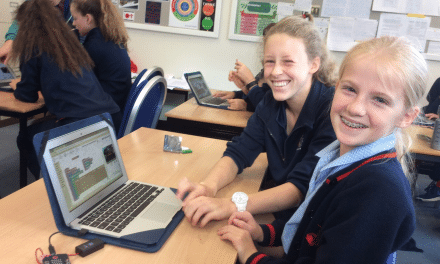
Girls at a UK primary school, playing the game they helped to code during a Code Created Coding Games Workshop.
When we visit schools to run our Coding Workshops or when I present at TeenTech events, I’m always struck by how universally enjoyed they are, and how excited all the pupils get about spending the day building some cool apps and games. I see them playing their games over break and lunch, showing their creations off to their friends. I put this engagement down to how inclusive the subject matter (apps, games, and devices) is. At the start of each session, I ask the students about the technology and the devices, apps and games they use. I’ve never seen a gender split on those that use technology or play games. Which is why the latest GCSE and A-Level numbers are both worrying and disappointing. Why are girls so interested in and engaging with technology, but are losing interested in computing qualifications?
In England, entries for GCSE Computer Science (which is replacing ICT), rose by almost 5,000 over last year. Of those 64,159 GCSE entries, girls made up just 20% of that number, a drop over last year’s numbers. ICT entries fell (as the subject is being phased out of the national curriculum) but, even there, entries from girls fell by 2% to 39%.
The A-Level statistics for 2017 are even more concerning. Only 9.8% of those completing a computing course were girls.
It’s worrying to see the drop in girls taking computing as a qualification, particularly as I feel like we’ve come a long way over the past few years, and it feels like – as an industry – we’re making progress in making computing and technology more accessible. But I guess we’ve got a long way to go.

My first ever computer… A Commodore Plus/4.
Many of the pioneers in computing were female. Ada Lovelace published the first algorithm intended to be executed by the early modern computer and is considered by many to be the first computer programmer. Grace Hopper was the first to create a compiler for a programming language and was one of the first programmers of the Mark I computer. Despite this, I think it is fair to say that males were very much the target audience in the early days of consumer computing and gaming.
Video gaming was, in the early days, a very male-orientated hobby. Video games were designed and developed by males for males. Games were being pitched by male developers to male publishers in an echo chamber. Then these games were marketed to males and then sold by male gamers, interested in games, working in game stores. In May 1982, sociologist Sidney J. Kaplan reported the gender split of arcade video game players to be roughly 80% male and 20% female. In 1989, according to Variety, women constituted only 3% of the gaming industry. So gaming, and making games, was so male dominated in the early days of consumer computing and gaming.
Change began to happen as PCs and consoles became more mainstream and computers became a utility that were useful to everyone, in any job, and for all students looking to get things done. As the possibilities and capabilities broadened, everyone saw value in computing. Whether it be for communicating with family, managing finances, looking at digital photos, managing digital music, or playing games – be it Grand Theft Auto or Solitaire. Suddenly software companies and game publishers realised they could no longer ignore 50% of the potential market, and started to make applications and games that were more inclusive. Platforms such as the Nintendo Game Boy boasted a 46% female demographic, a huge leap from 29% on their first mainstream console, the Nintendo Entertainment System (NES).
The problem was that these games were still being made by males and it took some time for the industry to make a start at becoming more inclusive. We’ve made progress but you only need to look at Gamergate, the Google memo from James Damores, and countless other similar incidents to see that we still fall short of where we should be. Latest estimates put the number of females working in game development at around 10%-12% (non-gaming technology companies have a slightly better ratio, which I’ll cover later), whilst the latest surveys suggest that 48% of those playing games are female. So there’s still a huge divide between the target audience and those working to make the products.
Gaming is everywhere, technology is everywhere, and it is universal. Regardless of age, and gender, everyone uses apps and everyone plays games. Technology is part of our daily lives. We all use it to get work done, stay in touch with family and friends, communicate ideas, and get from one place to another. The types of games we play may vary across demographics – my mum wouldn’t fire up a game of Fallout 4, but she’d happily get lost in Candy Crush or Wordament, or spend some time beating me at Kinect Sports over Xbox Live. When I visit schools, I’ve yet to meet a single pupil, male or female, that doesn’t play games.
That’s why it is disappointing to hear that less girls are engaging in Computer Science when I know that the excitement (and interest) is there.
“At less than 10%, the numbers of girls taking computing A-level are seriously low.” said Bill Mitchell, director of education at the IT Chartered Institute, BCS, speaking to the BBC. “We know that this a problem starting at primary school and it’s something that we need to address at all levels throughout education.”
“As a society, we need to make sure that our young women are leaving education with the digital skills they need to secure a worthwhile job, an apprenticeship or go on to further study.”
Through my work with TeenTech, I see girls engage with science and technology. In 2017, for the second year running, girls performed exceptionally well at the TeenTech Awards, with females making up over 60% of the winners. I had the privilege of mentoring several teams this year, and I was blown away by the standard of all the teams.
“We need to do more with the curriculum to show it’s not just a nerdy boys’ subject,” said Mr Mitchell. “We’ve got to show them it’s about real problems like climate change and improving healthcare.”

Our BBC micro:bit Workshop with girls from Thomas’s Clapham.
In addition to the Coding Workshops we run with UK Primary and Secondary Schools, we often run Coding Workshops for teachers after-school. During these sessions, we show teachers how universal technology is and give them some pointers as to how to engage everyone in coding.
Industries are being transformed by technology, and many jobs that exist today will not exist tomorrow due to advances in technology, especially around AI. It is vital that we prepare all students, regardless of their gender, in coding to prepare them for that future.
The fact is, girls are not at a disadvantage with computing because of nature. It is nurture, attitudes, and assumptions that is putting girls off engaging in what is still perceived as a male dominated industry. This is where we still have work to do. Many of the big companies are focussing on diversity. Microsoft now boasts a 26% female workforce in the US with equal pay between males and females, Google has a 31% female workforce, and Apple has a 32% female workforce (and 37% of their new hires are female). It is unclear how many of these roles are in engineering, but it is also very clear that diversity has become a large focus for technology companies. Hopefully these attitudes will filter down.
We’re also starting to see a huge rise in female protagonists in video games, and changes in the way females are portrayed. The rebooted Tomb Raider franchise features a Lara Croft who is tough, and confident, and extremely capable (rather than the sex-symbol Lara Croft from the start of the series). She’s a far more relatable and real character, even to me as a male gamer. And games such as Mass Effect: Andromeda, Horizon Zero Dawn, Alien Isolation, Uncharted, Mirrors Edge, Telltale Games’ The Walking Dead, and Life is Strange, all feature strong female leads.
We all need to do our bit to make coding, and a career in technology, universally appealing and inspiring. For me, personally, being able to relate to all the pupils I teach in my Coding Workshops, through my love of video games and mobile gaming, is a great starting point to the day and is a great way to hook the interest of all the pupils, as they’re all gamers too in some shape or form. Being able to talk about the people I work with in my job as a games developer (half of which are female) and what we achieve as a team helps too. Being able to explain the concepts of coding, and relating it to the games they play helps make coding more accessible and less daunting to all pupils.
We’re launching our Video Tutorials and Lesson Plans soon, as part of our new Online Resources. In these materials we’ll be focusing on how to engage students with coding just as much as we’ll focus on the coding languages and fundamentals (sign up for our new Newsletter to be notified when we’re live). Also, for any schools booking two or more of our Coding Workshops, we’ll run a complimentary session for your teachers, after school, free of charge, so we can give you some ideas on how to engage all your students, regardless of age, gender, or background.
Hopefully we can get the dial moving in the right direction.
Give us a call on 0845 299 3874, and for some free tips and tricks, sign up for our new Newsletter by filling in your details below.





